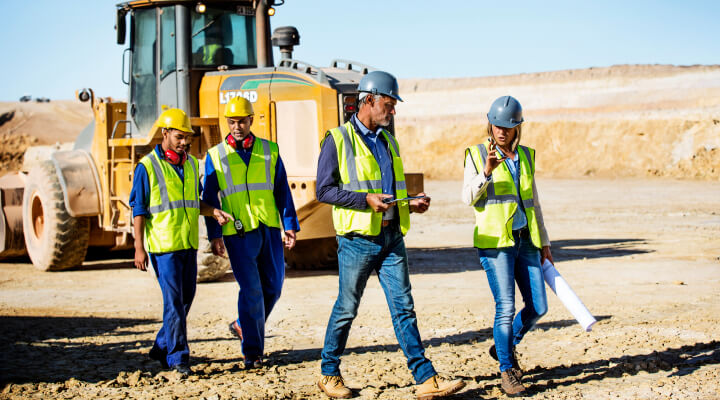
Author Archives: Monique


4 Oil and Gas Procurement Challenges (with Solutions)
The Oil and Gas industry is one of the most high-risk in the world. With Australia’s oil and gas workforce doubling over the last decade – and growth continuing – legislation is evolving to meet new advances. Those changes are reflected in the safety and compliance challenges facing the industry.
Read on to discover the most common oil and gas procurement challenges industry professionals face—and how you can overcome them.
1. Visibility and Flow of Supply Chain
Oil and gas supply chains aren’t always the most transparent. Many companies rely on oil and gas production from just a handful of countries. When disruptions occur, such as shortages and other economic impacts, it affects the oil and gas supply chain and procurement process at home.
How can you solve this?
The best way to overcome this challenge is to make the supply chain more transparent. How? Monitor the risks abroad, look for alternative suppliers in the event of shortages, and keep track of current prices each day.
The more you can break the supply chain process into manageable chunks, the easier it is to identify challenges, address them, and get the business back on track quickly.
2. Large Amounts of Data to Process and Interpret
When looking to improve procurement and supply chain management, you’ll quickly realise how much data you need to process and interpret every day—it’s a lot. It requires a dedicated person in your team to monitor and interpret this data.
Without doing this, companies may never have the chance to use the information they’ve discovered to create sustainable strategies to improve operations.
How can you solve this?
The best way to address this challenge is to partner with a data analytics expert. They can help you organise, process, and interpret the data that comes in each day. Using a dedicated platform for this process will help you avoid time-consuming and resource-draining information backlogs that interrupt your business’ flow and keep you from being able to expand at a reliable rate.
3. Difficulty Attracting Qualified Employees
One of the biggest contributors to oil and gas procurement issues is the employees and contractors that companies hire. Attracting high-quality talent can make all the difference in solving procurement challenges.
Having the right people – in-house or contractors – can help streamline the procurement process, keep an eye on the supply chain, and help implement changes which improve business. The wrong people can end up contributing to those issues, forcing companies to experience more delays and interruptions each day.
How can you solve this?
Investing in your hiring process and expanding your talent pool to other locations as needed can help you secure better talent. By focusing on quality hires, you’ll be more likely to attract talent that is willing to stay with your business for years to come, which reduces the amount of training you’ll need to pay for over time.
And don’t forget contractors! Working with vetted, qualified individuals along every step in your supply chain can make a big difference in the efficiency and productivity of your business.
4. Changing Demand for Oil and Gas
The oil and gas industry may be one of the more stable operating worldwide, but it’s not without its ups and downs. As more people transition to working remotely or working from home rather than making the standard commute to the office, demand for oil and gas will continue to go down.
This changing demand means the oil and gas procurement process needs to be more dynamic.
How can you solve this?
By keeping an eye on the demand and adjusting your supply chain as needed, you’ll be able to keep up with fluctuating demand levels without losing money. With supply chain analytics in place, you’ll be able to prepare for low-procurement periods and increases in demand without having to adjust things on short notice.
How Can the Oil and Gas Industry Be Improved?
The simplest way to improve the oil and gas procurement process is to embrace technology that’s designed to help streamline operations and reduce backlogs in data interpretation. In doing so, you’ll bring your business into the modern age and can eliminate many of the most common procurement challenges automatically.
Talk to Pegasus today about our Oil & Gas Solution.
A version of this blog first appeared on the Avetta blog here and has been republished with full permission.

Pegasus Helping Clients Manage COVID-19 Compliance

What Happens When You Partner With Pegasus?

Go Live: BESIX Watpac Joins Construction Solution

Four Key Safety and Compliance Lessons We Can Learn From COVID-19
COVID-19 changed the face of the world and businesses overnight. With the directive to work from home where possible and limit movements, businesses were given the ultimate stress test. Adapt to the changing times or risk closure.
While the past 18 months have been undoubtably difficult for businesses across Australia—even now with large sections of our east coast currently in lockdown—there have been many lessons in resilience and change learnt from COVID-19. These lessons don’t have to disappear when we finally live in a post-COVID world.
For instance, businesses who opted to set up new tiers of suppliers and contractors, have discovered new opportunities they can use after the pandemic as the business environment recuperates. The lessons learned will stay with them, allowing them to sustain operations during other future disasters.
Lessons about safety and compliance can also be instrumental in ensuring business continuity and profitability.
Here are four lessons on safety and compliance we can learn from COVID-19.
1 – Crisis Management Training
While contractor management services and safety training programs are usually part of workforce management systems, the pandemic has highlighted the importance of crisis management training for your workers. In the event of unforeseen circumstances such as bushfires, floods, other natural disasters or public health crises, how will your contracting companies adapt? Alongside safety and compliance qualifications, another piece of the puzzle to collect might be their crisis management plans.
Training will become essential in ensuring smooth and safe operations going forward. Imparting the training instruction effectively using cloud-based training platforms like the Pegasus Learning Management System (LMS) can be the key to ensuring effective worker management that raises the overall bar for operational efficiency.
2 – Worker Health Management
With QR codes and hand sanitiser a staple in every workplace and social distancing strongly encouraged, returning to work is unlikely to be straightforward. Fears of outbreaks are sure to be prevalent for months and potentially years.
With the safest companies set to dominate the future of work, it’s more important than ever to adopt stringent safety rules and keep stocks of hand sanitiser and cleaning products onsite to prevent any illness.
Working from home will remain the norm; with many never returning to the office full-time. Many businesses have already established remote working infrastructure to ensure workers remain productive. Regular health check-ups might become a thing of the future workplace.
3 – Cybersecurity Compliance
With automation on the rise, most businesses in a post-COVID world will use software-defined networks and advanced data analytics platforms to enhance decision-making. While leveraging technology is a great move, the flipside of it is that it comes with the risk of cyberattacks and data thefts.
For this reason, you will need stronger cybersecurity management systems than ever before. Prequalified system integrators and solution providers hold the key to ensuring cybersecurity compliance and protection from vulnerabilities.
4 – Workforce Data
It’s more important than ever to have complete visibility over your workforce.
The data collected in your Pegasus platform tells the story of your contracting companies and workers. There’s detailed information about all the companies who work for you and their relationships to one another.
It knows everything about your workers – their roles, who they work for, their attendance, and their competencies. You will see everything happening on your sites – who is working for you, where they are, their training, and what they can do.
When you resume operations, the stories in this data will allow you to see the contracting companies and workers who were the most efficient for your business.
Nobody can predict when the COVID-19 pandemic will end, but your constant efforts to stay prepared will help ensure worker safety and sustain your business when we return to a new normal in the workplace.
Talk to Pegasus today to find out how we are helping businesses adapt in a COVID-19 world.
A version of this blog first appeared on the Avetta blog here and has been republished with full permission.

Why You Need Real-Time Data Visibility

The Benefits of Clear Communication in the Workplace

Beginner’s Guide to the Work Health and Safety Act: What Happens If You’re Found In Breach?

The Value of Technology in the Remote Workforce
Making sure you meet your legislative requirements and that your workforce is qualified is important—especially when you deploy workers to remote sites.
The Australian mining industry is made up of large numbers of fly in, fly out (FIFO) or drive in, drive out (DIDO) workers due to the geographical location of their sites.
Managing your workforce data across several platforms presents the very real risk that something will be missed —from lapsed insurance, to missing medicals—which can lead to lost time, money, and the risk of fines.
From our origins in the Hunter Valley mining industry, Pegasus understands the unique challenges facing the industry. We partner with some of the world’s largest mine companies – including BHP, Glencore, Yancoal, and Peabody – to qualify and manage safety on their sites.
We know that in a high-risk working environment like mining, the stakes are high. A mistake can be deadly. But a remote mine site requires a different approach, something our clients often enlist our help with.
Understanding the Challenges of a Remote Site
McArthur River Mine in the Northern Territory is one of Glencore’s most remote Australian operations. Located 970 kilometres south-east of Darwin, staffing a mine site so remote presents its own unique challenges, and around half of the fifteen hundred-strong workforce are contractors.
Glencore was using several systems to capture all the information they needed to staff their mine and manage their safety requirements. But having data spread across multiple platforms was both inefficient and risky. What they needed was a robust contractor management system—one where they could identify contractors, ensure they had the right skills and training, and then deploy them to McArthur River Mine’s remote site.
It’s a similar story for Pegasus clients Peabody, with remote sites across Queensland and New South Wales, and Yancoal, who operates five producing mines, manages two mines, and has interests in another two joint venture mines across Queensland, New South Wales and Western Australia. Each hosts an array of workers and contractors, all of whom need clearances, inductions, training, and certifications to be able to do their jobs safely.
Creating a solution to do that effectively is the challenge.
Make Sure Your Workforce is Compliant BEFORE They Arrive
It is not worth the risk to have workers arrive to your remote mine site only to find out their insurances have expired, or they have missed crucial training due to policy changes.
This results in:
- Lost money flying them out;
- Lost time trying to rectify the issue; and
- Exposing your workforce to further risk by being down a worker.
So how do you avoid this? By leveraging technology.
It’s important to have certainty when it comes to your workforce. To know they have the appropriate licences, insurances, safety documents, and qualifications to work for you. Rather than having this information scattered across several static spreadsheets, it’s crucial to collect this information and hold it in one platform.
Yancoal has utilised our workforce management software to verify their contracting companies and workers before they are deployed to their mine sites.
“We now have business rules in the system that say, in essence, if certain people don’t have certain qualifications, they can swipe their card as many times as they want at the gateway but they won’t get in,” said Craig Hagan, Yancoal’s Training and Development Specialist.
Site Access and Automated Reminders to Keep Workers Compliant
Worker information being stored in an online, accessible, platform, empowers you to link their profile to site access. With only competent workers allowed on site, you’ll be able make sure every worker you fly in is compliant before they hop on the plane. Not only does it save you money, it gives your business confidence that no time is being wasted.
“Thanks to Pegasus, Peabody is more effective at making sure the people coming to site have met the training and competency requirements, this gives our Senior Management a lot more comfort that we are legally compliant,” said Shane Apps, Peabody Australia’s Senior Manager – Health, Safety and Training.
Getting your workforce compliant is one thing, but they must stay compliant. Whenever a licence, insurance, qualification, or induction is reaching expiry, our platform sends an automatic reminder to update the document or training. These notifications also work for changed site requirements.
This way, you reduce the risk – and time – of a worker being turned away at site.
Integrate with Existing Systems
Remote mine sites have the additional challenge of needing to manage travel and accommodation for your FIFO/DIDO workforce. Responding to this need and integrating multiple systems has become a Pegasus specialty. Our software development team can integrate systems—like Enterprise Resource Planning (ERP)s—using Application Programming Interfaces (APIs).
“The greatest benefit of working with Pegasus has been the high level of innovation and features available in their packages that aren’t available in other products we have investigated,” said Laurentiu Aldea, BHP Mt Arthur Coal’s Superintendent Site Systems.
With data talking between the systems, you have only the most up-to-date and accurate information to plan and scale.
Maximise Time with Online Learning
You’re days away from sending your worker to site when a procedure change occurs. Before they’re granted access to site, they need to complete training.
This is when you make the most of their time in transit. Workers on the way to site simply login to the Pegasus Learning Management System to complete their training. Now, on arrival, they’re up to date with new requirements.
“The system is allowing us to perform more efficiently by providing clear reporting on contractor management, training and attendance. We are able to more effectively manage competency, online learning and attendance while our contractors have gained a better understanding of their obligations,” said Talan Breaden, Aeris Resource’s Manager of People & Safety at their Tritton Operations.
Finding the right technology to manage the complexity of your remote workforce will streamline your processes, increase productivity, and save time. It ensures your risk is managed.
Talk to the experts at Pegasus today.
FREE WEBINAR – AUTHENTIC LEADERSHIP
DATE: 4 November 2021 TIME: 1 pm (AEDT)
Authentic leadership is about bringing your true self to your role – the good and the bad. In this webinar, presented by industry expert Kim Nguyen – Core Mine Training, we explore why authentic leadership is crucial for any high performing team, and how to cultivate it.
Host: John Furner, Pegasus Head of Mining Services



